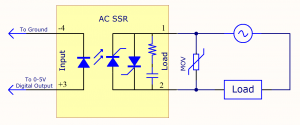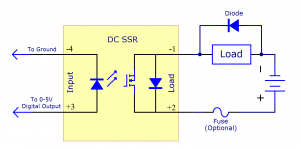Solid State Relay Guide
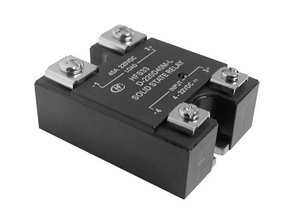
|
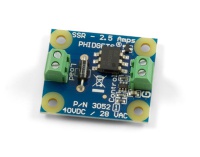
|
Introduction
Solid state relays (SSRs) turn on or off the power being supplied to other devices without the need of a physical switch. With relays, you control high-current devices with low-current signals, like a standard DC signal from a Digital Output.
They perform the same job as Mechanical Relays, but have the following advantages:
- SSRs produce less electromagnetic interference during operation, as opposed to mechanical relays, where internal contacts spark when switching.
- The switch contacts of a mechanical relay will eventually wear down from sparking. An SSR will have a longer life because its internals are purely digital. Properly used, they will last for millions of cycles.
- SSRs turn on and off faster than mechanical relays (≈1ms compared to ≈10ms).
- SSRs are less susceptible to physical vibrations than mechanical relays.
- Since the switch inside an SSR isn't a mechanical switch, it does not suffer from contact bounce, and operates silently.
SSRs are more expensive to produce and will dissipate more energy in the form of heat (1-2% of the energy intended to power the load).
How it Works
The control inputs are connected internally to an LED, which shines across an air gap to light sensors. The pairing of an LED with light sensors is called an optocoupler, and is a common technique to link two parts of a circuit without direct connection. The light sensor is connected to the transistors which open or close, supplying the relay's load with power.
Basic Use
Controlling an SSR is no more complicated than driving an LED. There are many ways of accomplishing this with Phidgets -
- Link to Digital Output Page, SSR Section
- Link to Digital Output Page 0/16/16, SSR Section
- Link to LED Output Page, SSR Section
The ability of an SSR to switch a load is very similar to a relay or simple switch. In practice however, there is no one SSR perfect for all applications. To choose an SSR for your application, please follow #Choosing an SSR
Safety
Relays can switch high currents and voltages, and standard precautions apply. Make sure you never touch the terminals while the relay is powered, and if your SSR came with a plastic cover, use it. Even when the SSR is switched off, a very small amount of current will flow.
When an SSR fails, it most often fails permanently closed - leaving your load powered, and possibly creating a fire or safety hazard.
Choosing an SSR
I need to switch AC
Most AC applications will be switching 110 to 240 Volt power coming from the grid. If that's you, #Mains Voltage (110 to 240V AC)
We also cover low voltage AC applications - 28 VAC or less. #AC/DC SSRs
I need to switch DC
If you don't need to switch a lot of current - 9 Amps or less, consider our cost effective (and small!) #AC/DC SSRs.
At more than 9 Amps, you need a serious #DC SSRs
Mains Voltage (110 to 240V AC)
Identify your voltage
We sell AC SSRs for 120 VAC or 240 VAC operation. Look for this on the SSR Product pages under the Maximum Load Voltage specification. If you are unsure what voltages you could be switching in the future, the 240 VAC relays can be used to switch 120 VAC. Please note we are very conservative in how we rate relays - our 120 VAC relays are rated by the manufacturer for 240 VAC, and the 240 VAC for 380 VAC - but we strongly recommend against using them to the manufacturer rated voltage. To understand why, read the #AC SSR Protection section.
Identify your current
The current drawn by your load when turned on affects how large of an SSR you need, and how hot it will be when it runs. If you know how much current, on average, your load draws, this is what we call Average Load Current. If you don't know the average current, but you know the wattage of your device, you can calculate Average Load Current by:
Average Load Current = Wattage / Operating Voltage
Next, we need to know the current drawn by your device when it is first turned on. Many devices demand a huge inrush of current, stressing electronics. If you've ever noticed the lights dimming in the house for a second when the furnace kicks in, this is the fan motor starting up. It's very difficult to measure the Surge Current itself, so we use a multiplier based on your device type. Surge Current may also be known as inrush current.
- What other kinds of AC devices will our customers want to connect? PCs, Microwaves,
TABLE - surge current multiplier Incandescent Light Bulbs Fluorescent Light Fixtures Motors Transformers Heaters
Multiply your Average Load Current by the multiplier for your device type to calculate the Surge Current.
Load Type - Inductive vs. Resistive
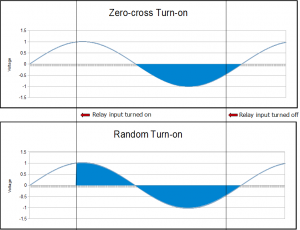
SSRs are designed to either turn on immediately (Random Turn On), or wait until the next 'alternation' of the voltage (Zero Crossing). Zero Crossing SSRs create less electromagnetic 'noise' when they turn on, and MIGHT TBD cost more money. They are best used with resistive loads - Zero Crossing SSRs are not able to turn off some inductive loads. It's very difficult to determine which inductive loads will create problems - well beyond the scope of this document. If your load is inductive, we recommend buying the Random Turn On SSRs.
Your Load will probably be inductive if it is built around a large coil of wire - motors and transformers are typical examples. A load considered resistive may also have loops of wire - for instance, hair dryers, toasters, incandescent bulbs use twisted wire elements to generate the heat. An inductive load will have thousands of loops of wire - it's a matter of scale. There is no such thing as a perfectly resistive load - but the load has to be really inductive to cause the zero crossing SSRs to malfunction.
Another good reason to use Random Turn On SSRs for inductive loads is the coils will be wrapped around a magnetic material like iron. As the current flow generates magnetic fields, the iron is repeatedly magnetized in opposite directions. Depending on how the iron was magnetized when the power was removed, and your luck when the load is turned on, an effect called saturation can produce a huge inrush of current. Zero Crossing SSRs are more likely to turn on the load at exactly the worst time.
TABLE - specify inductive / resistive
- Incandescent Light Bulbs Resistive
- Fluorescent Light Fixtures Older units (magnetic ballast) may be inductive, newer units resistive (electronic ballast)
- Motors Inductive
- Transformers Inductive
- Heaters Resistive
- Computer / Electronics
- AC/DC power supplies (brick heavy type) Inductive
- AC/DC Power supplies (lightweight switchers) Resistive
Remember, if your load is inductive, choose a Random Turn On relay. If your load is resistive, choose a Zero Crossing relay.
Picking your AC SSR
Now that you have identified your Operating Voltage, Average and Surge Current, and your load type (inductive or resistive), you can create a short list of relays whose
- Maximum Load Voltage are greater than or equal to your operating voltage,
- Maximum Surge Current are greater than or equal to your surge current, and
- Turn On Type matches what you chose for random turn on/zero crossing.
Now compare the Load with No Heatsink value for the SSRs on your list to your Average Load Current. If your Average Load Current is greater, you need a heat sink. For picking a heatsink, please go to #Picking a heatsink Consider other SSRs on your list - there may be an SSR that can handle your average load current with no heatsink.
At this point, you know the SSR you need.
Instead of simply turning the load on/off, do you want to dim it? SSRs that are able to reduce the average power to the load are called Proportional Control SSRs. Read about them here
AC SSR Protection
Your AC SSR from Phidgets comes with a circular disc with two legs. <Picture> This is a Metal Oxide Varistor (MOV) and should be installed across the load (larger) terminals of your SSR <Picture>. MOVs are the classic surge protector - an inexpensive component that absorbs high voltage spikes. High voltage spikes are caused by inductive loads when they are turned off, and also happen very often on the electrical grid, as nearby devices are operated. Even if your load is resistive, use an MOV to protect the SSR.
MOVs have a limited life span - they must be carefully chosen. If an MOV is chosen for too low of a voltage spike, it will wear out quickly. If it is chosen for too high of a voltage spike, it will not protect the SSR adequately. MOVs are not perfect devices - therefore we have chosen SSRs which can survive much higher voltage spikes than what we recommend them for. For example, this is why the AC SSRs we recommend for 120 VAC operation are rated by the manufacturer for 240 VAC. If you must operate our AC SSRs are higher voltages than we recommend, do not use the included MOV.
As MOVs wear out from use, they will become more sensitive to common voltage spikes, causing them to wear out quicker. When they entirely fail, they will become a short circuit, potentially creating a fire hazard. The MOV included with your SSR has a fuse built in which will disable the MOV when it becomes a hazard. Please consider (and avoid!) nearby flammable material when mounting your SSR.
- TMOV20RP200E
- TMOV20RP385E
Proportional Control SSR
Proportional Control Relays (often simply called "Control Relays") are SSRs you can use to control the amount of power to the load. Rather than reduce the voltage, or somehow limit the current - which would be very expensive solutions, the Proportional SSR reduces power by turning the load on/off quickly, feeding full power in short pulses. A similar technology is used for motor control, called PWM (Pulse Width Modulation).
Proportional SSRs are controlled by a variable voltage - as the voltage increases, more power is available to the load. Our PhidgetAnalog product can be used to control Proportional SSRs. We don't sell Proportional SSRs - but they can be purchased from Digikey, where they are called AC Linear Controlled SSRs.
A quick and dirty (and inexpensive!) solution for dimming with Phidgets is to use an RC Servo Motor with a PhidgetAdvancedServo to rotate the knob on a light dimmer. From software, the RC Servo Motor is rotated to an absolute position, cranking the knob as it turns. Link to Servo Motor Primer
Example circuits with AC SSRs
When wiring up an AC circuit, particularly for long term installation, you may find it helpful to buy a book on residential wiring from your local hardware store. There are many wiring conventions (and often legal codes) which will help you plan your project, and the legal codes are often a great source of wisdom.
- Show diagram of switching 240V 1-ph load, and 240V split phase (like your stove)
DC SSRs (0 to 50V DC)
Identify your voltage
We sell DC SSRs for up to 50 Volts DC Operation. Look for this on the SSR Product pages under the Maximum Load Voltage specification. If you are unsure what voltages you could be switching in the future, higher voltage DC SSRs can be used to switch lower voltages. If your voltage is close - be conservative. For instance, a 24 Volt system built from 2 Lead Acid batteries can reach 30 volts when charging - so using a 30V SSR would be cutting it close.
Identify your current
The current drawn by your load when turned on affects how large of an SSR you need, and how hot it will be when it runs. If you know how much current, on average, your load draws, this is what we call Average Load Current. If you don't know the average current, but you know the wattage of your device, you can calculate Average Load Current by:
Average Load Current = Wattage / Operating Voltage
Next, we need to know the current drawn by your device when it is first turned on. Many devices demand a huge inrush of current, stressing electronics. If you've ever noticed the lights dimming in the house for a second when the furnace kicks in, this is the fan motor starting up. It's very difficult to measure the Surge Current itself, so we use a multiplier based on your device type. Surge Current may also be known as inrush current.
TABLE - surge current multiplier
Incandescent Light Bulbs 6x
Motors 6x
LEDs 1x
Complex Electronics i.e., Motor Controllers, Phidgets 6x
Multiply your Average Load Current by the multiplier for your device type to calculate the Surge Current.
Picking your DC SSR
Now that you have identified your Operating Voltage, Average and Surge Current, you can create a short list of relays whose
- Maximum Load Voltage are greater than or equal to your operating voltage,
- Maximum Surge Current are greater than or equal to your surge current, and
Now compare the Load with No Heatsink value for the SSRs on your list to your Average Load Current. If your Average Load Current is greater, you need a heat sink. For picking a heatsink, please go to #Picking a heatsink Consider other SSRs on your list - there may be an SSR that can handle your average load current with no heatsink. The larger SSRs will be more efficient for the same current.
At this point, you know the SSR you need.
DC SSR Protection
Your AC SSR from Phidgets comes with a diode. <Picture> This diode should be installed across your load, with the Cathode installed towards the power supply. <Picture of the diode across a load, with the SSR>
If the diode is installed backwards, as soon as the SSR is turned on, the load will be shorted out, likely destroying the diode, or the SSR, or your power supply. A fuse protecting your power supply is always a good idea. <Picture of fuse inline close to the power supply>
The diode protects the SSR from powerful residual currents after the SSR is turned off. These residual currents are used to produce the sparks for spark plugs - they are easily capable of destroying your SSR. The diode allows these currents to recirculate in the load until they have lost their energy.
Example circuits with DC SSRs
The electrical isolation built into a DC SSR allows them to be placed within a circuit just like a switch. Circuits without electrical isolation require a lot more care - proper grounding, voltage offsets.
With a DC SSR, always make sure the positive load terminal (labeled +) towards the power supply. If the load terminals are reversed, your load will immediately turn on - there is a diode inside of the SSR.
The DC SSR can be installed on either side of the load, and it will work properly, but there is an advantage to installing the SSR between the power supply and the load. If the load is connected to the power supply, it will always have a potentially dangerous voltage on it, even when it is not operating.
Diagram of a power supply -> fuse -> SSR -> load -> power supply ground.
Did you know?
SSRs, and semiconductors in general, usually fail as a short circuit. This means your load will probably turn on permanently (or until you remove the power) - make sure this doesn't cause a safety hazard. For instance, Sauna Heaters have a simple mechanical thermal shutdown to protect if control electronics fails.
DC SSRs (at least the units we sell) use MOSFETs - Metal Oxide Semiconductor Field Effect Transistors. Say that three times fast. MOSFETs do not lose a constant voltage - instead, when they turn on, they act as a very slight restriction to the flow of current - a resistor. At low currents, the slight restriction wastes very little power, giving high efficiency and often not requiring a heat sink. This efficiency is lost as the current increases - a doubling of current quadruples the production of heat.
MOSFETs can switch AC, but a single MOSFET has a diode in parallel with it. The MOSFET can only block current in one direction - as soon as the voltage reverses, the current flows through the diode. If a MOSFET is used to switch AC, your load will be turned on half the time. A solution is to use two MOSFETs back to back - which is what we do with our AC/DC SSRs.
AC/DC SSRs (0 to 40V DC / 0 to 28V AC)
Our AC/DC SSRs are built on a small PCB, making them physically smaller than the hockey puck SSRs, and less expensive. They are limited to lower currents, and cannot be mounted on a heatsink. <Put in a picture of the 3052 SSR, with an arrow showing the SSR chip on the board>
Identify your voltage
We sell AC/DC SSRs that can switch up to 40 Volts DC or 28 Volts AC. Look for this on the SSR Product pages under the Maximum Load Voltage specification. There is no lower limit on the voltages that the AC/DC SSRs can switch. If your voltage is close - be conservative. For instance, a 36 Volt system built from 3 Lead Acid batteries can reach 45 volts when charging.
Identify your current
The current drawn by your load when turned on affects how large of an SSR you need, and how hot it will be when it runs. If you know how much current, on average, your load draws, this is what we call Average Load Current. If you don't know the average current, but you know the wattage of your device, you can calculate Average Load Current by:
Average Load Current = Wattage / Operating Voltage
Next, we need to know the current drawn by your device when it is first turned on. Many devices demand a huge inrush of current, stressing electronics. If you've ever noticed the lights dimming in the house for a second when the furnace kicks in, this is the fan motor starting up. It's very difficult to measure the Surge Current itself, so we use a multiplier based on your device type. Surge Current may also be known as inrush current.
TABLE - surge current multiplier
Incandescent Light Bulbs 6x
Motors 6x
LEDs 1x
Complex Electronics i.e., Motor Controllers, Phidgets 6x
Multiply your Average Load Current by the multiplier for your device type to calculate the Surge Current.
Picking your AC/DC SSR
Now that you have identified your Operating Voltage, Average and Surge Current, you can create a short list of relays whose
- Maximum Load Voltage are greater than or equal to your operating voltage,
- Maximum Surge Current are greater than or equal to your surge current, and
- Maximum Average Current is greater than or equal to your Average current.
If you are interested in minimum cost, you will likely choose the cheapest option that meets these criteria. If you are interested in high efficiency operation and less heat generation, consider buying an SSR with higher current rating.
Your AC/DC SSR from Phidgets has built in protection from static electricity, and dangerous residual currents after the SSR is turned off. If you are switching DC, installing a diode across the load will offer even more protection. Refer to the #DC SSR Protection section for more information.
Example circuits with AC/DC SSRs
<Schematic of an AC/DC SSR switching a DC Load. Point out that the AC/DC ssr output terminals are bidirectional - it doesn't matter which way you hook them up. Show the optional diode, make sure it's clear that it's optional>
<Schematic of an AC/DC SSR switching an AC Load>
The electrical isolation built into a AC/DC SSR allows them to be placed within a circuit just like a switch. Circuits without electrical isolation require a lot more care - proper grounding, careful consideration of voltage offsets.
Using heatsinks with Hockey Puck SSRs
SSRs will only achieve their promise of reliability and long life if they are kept cool. Cool is relative, of course, but a good rule of thumb is to keep the metal base of the SSR at less than 85 Celsius.
Excess heat usually comes from too much current and too little heatsinking. A lot of heat can also be generated by turning the relay on and off frequently. If your relay is being operated for brief periods of time, you may not need as large of a heatsink - provided the relay is never accidentally left on for extended periods. Unless space is a concern, it's better to err on the side of caution.
Do you actually need a heatsink? If your application is running at room temperature, and your average current is less than the Load with no Heatsink specification of your SSR, then no, you don't need a heatsink.
- Based on your knowledge of your application, do you need a heat sink?
- Check your SSR's data sheet to get an idea of the amount of heat it will be generating based on your application's load.
- If the SSR cannot be mounted on a surface that is suitable for conducting away the heat, you should use a heatsink.
- How to tell if SSR is "too hot"?
- causes of excess heat- too much current or too little heatsinking
During the discussion of the generation of heat, we can introduce the hockey puck physical form factor, and how that is relevant to heat sinks.
Phidgets includes a grey pad with our Hockey Puck form factor SSRs. You place this pad under an SSR when mounting it on a heatsink, or on large metal surfaces that can dissipate heat. The pad takes the place of thermal grease - if you are more comfortable with thermal grease, you can use it instead.
Our heat sinks include screws for mounting SSRs. <Show picture of heat sink + thermal pad + SSR>, and another picture assembled.> Use a good size screwdriver when tightening the SSR down on the heat sink.
Hooking up wires to the Hockey Puck SSR
< Need picture of wires clamped onto the SSR, with the MOV on top >
When wiring your load to the SSR, the wire is looped clockwise around the terminal, so as the screw is tightened down, it will draw the wire in tighter. We recommend using wires up to 10 AWG in size - any larger, and the screws will not have enough thread left to tighten down, and they will strip. 10 AWG wiring is conservatively rated at 30 Amps, TBD posing a problem to use SSRs rated higher than 30 AMPS. Larger wires can be attached using a wiring lug. The lug is clamped under the SSR screw, and the wire attaches to the lug. <picture of TRM6 on SSR with big wire attached>
Loose wire connections can generate a lot of heat - use a good size screwdriver when clamping down the load wires.
For the current ratings of various wires sizes, please see Page on Wire Sizes
Did you know?
Mains Voltage AC SSRs cannot switch DC. They will never turn off. AC SSRs turn off twice per AC Cycle - in North America, AC is 60 Hz, so the AC SSR has 120 opportunities per second to turn off. If the SSR is operating from DC, the current will flow continuously, and the SSR will not turn off, even when the control input is off.
An AC SSR turns off automatically every time the current is zero. An AC SSR will have a current value that it regards as 'zero'. If your load requires less than this current, your SSR will never turn on - or will not reliably turn on.
Very fast voltage changes can disturb the internal circuitry on an AC SSR enough to turn it on accidentally. SSR Manufacturers protect against this by adding a simple circuit inside the SSR, across the load terminals, called a snubber. The snubber absorbs very fast electrical changes, converting them to heat. When the AC SSR is turned on, there is little voltage difference between the terminals, so the snubber has very little effect. When the AC SSR is turned off, the snubber is actively protecting the SSR - but at a cost, as it allows a small current through the SSR, which is wasted.
An AC SSR uses bipolar transistors - an old technology that has been replaced by CMOS transistors in modern digital circuits. Bipolar transistors are still superior for handling high voltages. Bipolar transistors, and the more complex transistors built from them, will lose a constant voltage as current flows through them. The collection of transistors in your SSR will lose about 1.7 volts - so on a 120 VAC system, you will lose about 1.5% to the SSR. This energy goes into heating the SSR, and the heating from these transistors is the reason SSRs often need heat sinks.
SSRs, and semiconductors in general, usually fail as a short circuit. This means your load will probably turn on permanently (or until you remove the power) - make sure this doesn't cause a safety hazard. For instance, Sauna Heaters have a simple mechanical thermal shutdown to protect if control electronics fails.
DC SSRs (at least the units we sell) use MOSFETs - Metal Oxide Semiconductor Field Effect Transistors. Say that three times fast. MOSFETs do not lose a constant voltage - instead, when they turn on, they act as a very slight restriction to the flow of current - a resistor. At low currents, the slight restriction wastes very little power, giving high efficiency and often not requiring a heat sink. This efficiency is lost as the current increases - a doubling of current quadruples the production of heat.
MOSFETs can switch AC, but a single MOSFET has a diode in parallel with it. The MOSFET can only block current in one direction - as soon as the voltage reverses, the current flows through the diode. If a MOSFET is used to switch AC, your load will be turned on half the time. A solution is to use two MOSFETs back to back - which is what we do with our AC/DC SSRs.

